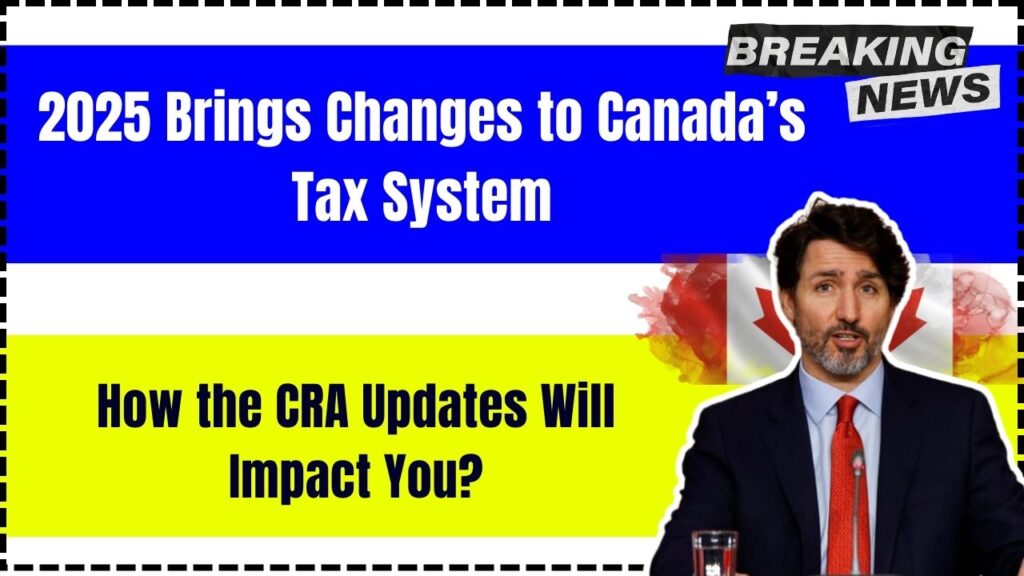2025 Brings Changes to Canada’s Tax System: As we step into 2025, many Canadians are asking: “What does this year bring for our taxes?” The good news is that the Canada Revenue Agency (CRA) has introduced a series of updates aimed at improving the transparency, security, and efficiency of the tax system. These changes are particularly relevant in today’s fast-evolving economic landscape, as more Canadians embrace digital commerce, remote work, and diversified income sources.

Understanding how these updates impact you is crucial, whether you’re a salaried employee, a gig worker, a retiree living off investments, or a small business owner navigating both provincial and federal requirements. This article unpacks the 2025 CRA tax changes in a simple, straightforward way, offering real-life examples, practical advice, and expert-backed analysis. We’ll help you stay compliant while also taking advantage of opportunities to save or grow your money.
2025 Brings Changes to Canada’s Tax System
| Category | Details |
|---|---|
| Capital Gains Tax | No increase in the capital gains inclusion rate. Remains at 50%. Source |
| Digital Services Tax (DST) | 3% DST applies to digital services revenue; retroactive to Jan 1, 2022. More Info |
| Direct Deposit Changes | CRA no longer accepts updates via EFILE or phone as of March 24, 2025. CRA Direct Deposit |
| TFSA Contribution Limit | Increased to $7,000 in 2025. Lifetime limit now $102,000. TFSA Details |
| Carbon Tax Repeal | Federal consumer carbon tax repealed effective April 1, 2025. Carbon Pricing Info |
Canada’s 2025 tax updates reflect a shift toward greater financial security, fairness, and digital modernization. With capital gains tax holding steady, TFSA limits increasing, and the carbon tax repealed, there are plenty of opportunities for Canadians to improve their financial outlook this year.
Whether you’re filing your own taxes or running a business, the key is to stay informed, make strategic decisions, and leverage tools provided by the CRA. Proactive planning today can lead to meaningful savings tomorrow. Consider speaking with a qualified accountant or financial advisor to optimize your strategy based on these new rules.
Understanding the CRA’s 2025 Tax Changes
Let’s explore the most impactful changes Canadians need to know, with added depth and practical insights.
1. Capital Gains Tax Stays Steady
Despite mounting speculation in 2024, the federal government decided not to increase the capital gains inclusion rate. For investors, retirees, and small business owners, this decision brings welcomed stability.
- What this means: You only need to include 50% of any capital gains in your taxable income. This applies to assets like stocks, rental properties (not your primary residence), and business sales.
- Practical Impact: Suppose you sold shares for a $100,000 gain. Only $50,000 of that is added to your income for tax purposes.
- Context: This move follows widespread pushback from economic experts and small business advocates who warned an increase could discourage long-term investments.
Pro Tip: Use the CRA Capital Gains Calculator to run different scenarios and optimize your year-end tax planning.
2. Digital Services Tax: Who’s Affected?
Introduced in 2024 and now being enforced, the Digital Services Tax (DST) is a 3% levy on large tech companies and digital marketplaces.
- Scope: Companies with more than €750 million in global revenue and over CAD $20 million in Canadian digital income.
- Applies to: Online marketplaces (Amazon), digital ad platforms (Meta, Google), social networks, and data monetization services.
- Important Note: It is retroactive to January 1, 2022, and payments are due by June 30, 2025.
Implications for Consumers: While not directly taxed, many digital platforms may pass on costs to users or vendors. If you run a small e-commerce store using one of these platforms, you might see fee increases.
Advice for Businesses: If you’re unsure whether your company falls under DST requirements, speak to a cross-border tax specialist or explore CRA’s guidance portal.
3. Direct Deposit Rules Have Changed
To boost security and reduce fraud, the CRA implemented stricter procedures for managing direct deposit information as of March 24, 2025.
- You can no longer update banking info via EFILE or over the phone.
- Updates must be made through CRA My Account or your bank.
Why this matters:
- It reduces the risk of scams and identity theft.
- It ensures your refunds, GST/HST credits, and child benefits reach the correct account without delays.
Tip: Set calendar reminders to review your CRA account details each tax season. Errors in banking info can cause month-long delays in receiving refunds.
4. Bigger Room in Your TFSA: Maximize It
The TFSA contribution limit for 2025 is $7,000, up from $6,500 in 2024. The cumulative lifetime limit for eligible Canadians (since 2009) is now $102,000.
- Why this matters: Investment income (interest, dividends, capital gains) earned inside a TFSA is completely tax-free.
- How to leverage: Use your TFSA to invest in index funds, GICs, or even high-yield dividend stocks without any tax on the growth.
Example: A 30-year-old who invests their full TFSA room in a portfolio with a 5% annual return can grow their money to over $170,000 by age 50.
Common Mistake to Avoid: Over-contributions are subject to a 1% monthly penalty, so double-check your available room on MyCRA.
5. Carbon Tax Repeal – What It Means for You
In a major shift, the federal government repealed the consumer carbon tax, effective April 1, 2025.
- Immediate Effects: Gas stations and utility companies no longer collect the federal carbon levy.
- Financial Relief: Average households may save $300–$500 annually depending on fuel consumption.
Important: Provinces like British Columbia and Quebec still maintain their own carbon pricing schemes, so the overall savings will depend on where you live.
What You Can Do:
- Check your province’s website for updates.
- Track utility bills to see if the repeal translates into lower monthly costs.
How to Boost Your CPP Pension by $2,700 Annually in 2025: Steps to Claim Your Boost!
Is Transferring Your RRSP for a Bonus in 2025 Worth It? Here’s What You Need to Know!
New CPP Rules for 2025: Increased Eligibility, Higher Amounts & Deposit Dates
FAQs About 2025 Brings Changes to Canada’s Tax System
Q1. How can I update my CRA direct deposit info in 2025?
A: You must use your CRA My Account or update it through your bank. CRA no longer accepts phone or EFILE updates.
Q2. Who pays the new Digital Services Tax?
A: It applies to large multinational digital firms earning substantial Canadian revenue. It doesn’t impact everyday users or small local businesses.
Q3. How much can I contribute to my TFSA this year?
A: The 2025 limit is $7,000. If you’ve been eligible since 2009 and never contributed, your total contribution room is now $102,000.
Q4. Will I still pay carbon tax on gas and utilities?
A: The federal carbon tax is gone as of April 1, 2025. Some provinces still have their own levies, so your savings will vary.
Q5. Is capital gains tax going up this year?
A: No. The inclusion rate remains at 50%. The proposed hike was canceled in March 2025, bringing relief to investors and business owners.








